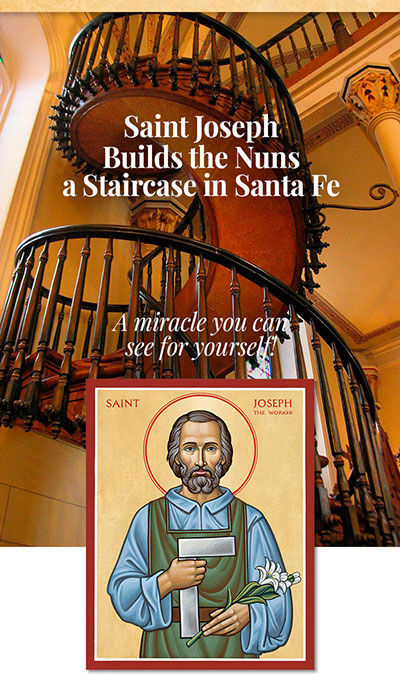A Miracle You Can See!
 When the Loretto Chapel of the Sisters of Loretto in Santa Fe, New Mexico was completed in 1878, there was no way to access the choir loft twenty-two feet above. Carpenters were called in to address the problem, but they all concluded access to the loft would have to be via ladder - completely impractical for the sisters - as a staircase would interfere with the interior space of the small Chapel.
When the Loretto Chapel of the Sisters of Loretto in Santa Fe, New Mexico was completed in 1878, there was no way to access the choir loft twenty-two feet above. Carpenters were called in to address the problem, but they all concluded access to the loft would have to be via ladder - completely impractical for the sisters - as a staircase would interfere with the interior space of the small Chapel.
To find a solution to the seating problem, the Sisters of the Chapel made a novena to Saint Joseph, the patron saint of carpenters, placing the construction under his care. On the completion of the novena
an old, gray-haired, gray-bearded man appeared, leading his donkey and carrying a simple tool collection of a saw, a carpenter's square, and a hammer. Months later the elegant circular staircase was completed, and the carpenter disappeared without pay or thanks. After searching for the man (an ad even ran in the local newspaper) and finding no trace of him, some concluded that he was Saint Joseph himself, having come in answer to the sisters' prayers.
The Santa Fe staircase is not only magnificent, it is also miraculous. The design was innovative for the time, and even today experts cannot explain the miraculous strength of its construction. The staircase has two 360 degree turns and no visible means of support. It is said that the staircase was built without nails--only wooden pegs. In 1996 a wood technologist completed a study of the wood used for the staircase and reported it was a species of spruce heretofore unknown, with unique square-shaped structure cells.
Over the years thousands have flocked to the Loretto Chapel to see the Miraculous Staircase. The staircase has been the subject of many articles, TV specials, and movies including "Unsolved Mysteries" and the full-length movie titled "The Staircase", starring William Petersen and Barbara Hershey.

After almost five centuries of venerating Saint Joseph on the feast day of March 19th, why in 1955 did Pope Pius XII create the feast day of Saint Joseph the Worker?
In 1889 Socialists declared May 1st "International Workers' Day," known more popularly now as "May Day" - a day which in subsequent years became the day for labor protests, many of them violent. It eventually was a day much championed by Communists in the Soviet Union and Eastern Europe.
To counteract this violence and to reclaim the Christian dignity of work, Pope Pius XII created the solemnity of Saint Joseph the Worker, also to be celebrated on May 1st, explaining that "the humble craftsman of Nazareth not only embodies the dignity of the worker; he is also the guardian of you and your families."
Monastery Icons' icon of Saint Joseph the Worker is available in our full selection of formats and sizes.